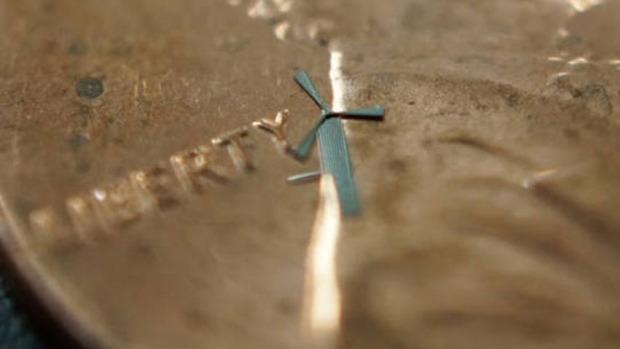'Micro-windmills' could charge cellphones, inventors say
University of Texas team builds 1.8-mm-wide power-generating device
By Matt Kwong, CBC News Posted: Jan 15, 2014 2:54 PM ET Last Updated: Jan 15, 2014 2:54 PM ETQuote
A 'micro-windmill' designed by researchers with the University of Texas at Arlington is shown on top of a penny. The device's designers say the windmills could be used in the future to charge cellphones or power homes. (University of Texas at Arlington)
Researchers in Texas have created a windmill so small it appears as a speck on the surface of a penny. But they say a multitude of the micro-machines, linked together, could someday generate enough energy to charge up a cellphone or a house.
"Imagine your phone is out of battery, so you take out a sleeve that has 1,000 windmills on it and wave it in the air for a few minutes," said Jung-chih Chiao, an electrical engineering professor at the University of Texas at Arlington. "That could give you enough power to get by and send a message."
The micro-windmill is only 1.8 millimetres at its widest point. As many as 10 of the tiny devices could fit on one grain of rice.
Chiao, who designed the micro-windmill prototype with research associate Smitha Rao, said it was fabricated using nickel alloy components that are flexible and durable.
The device was built using a subset of the micro-fabrication process for the tiny semiconductors used in everyday electronic circuits.
Origami principles used
The windmills are then constructed from ultra-thin slices of semiconductor material known as a wafers.
"A windmill is a three-dimensional structure, but the semiconductor fabrication technique is two-dimensional," Chiao told CBC News from Arlington.
"So how do you do it? A simple way of thinking about this is like origami."
Assembling windmills using tweezers and constructing them like gingerbread houses would be too difficult due to the micro-scale of the assembly, he said.
"But with origami, sometimes you fold one side and the other side will stand up. We're using that kind of principle," Chiao said, adding that producing one micro-windmill would cost the same as making 1,000 because they would be on the same wafer.
While the University of Texas team has not been able to disclose how much electricity was generated with the micro-windmill, because of a patent application that's still being filed, Chiao said the use of thousands of the windmills together could eventually provide enough power to run a household's security, communication and lighting systems.
Dust friction a challenge
"We got the idea because I didn't want to put a big wind turbine in my backyard, but I have a lot of wind there because I live near an airport," Chiao said. "I thought, 'Can I just set something up so I can power a sensor or light at night?'"
A flat panel of 10,000 micro-windmills mounted on a six-foot by six-foot window might be able to do the trick, he says.
Similarly, a smartphone case studded with windmills could be useful in emergency situations after the sun has set and a person needs to contact the outside world but has run out of battery. Even holding the phone out for several minutes during a windy day could power up the battery, Chiao says.
"Sometimes there's not enough solar energy and sometimes you don't have the connector available that can plug into the power outlet," he said.
Chiao and Rao, who works with micro-robotic devices, are now in talks with the Taiwanese fabrication foundry WinMEMS Technologies Co., about commercializing their invention.
The researchers are still exploring potential physics challenges that might limit the design, such as friction problems that might occur if a piece of dust jams the mini-rotor blades.
Results 1 to 1 of 1
-
01-17-2014, 12:40 AM #1
 Sage
Sage


















- Join Date
- Mar 05, 2012
- Location
- inside hehhehheh's vagina
- Posts
- 10,065
- Gameroom Cash
- $97584
- Rep Point
- 17972
- Rep Power
- 42
'Micro-windmills' could charge cellphones, inventors say
'Micro-windmills' could charge cellphones, inventors say
University of Texas team builds 1.8-mm-wide power-generating device
By Matt Kwong, CBC News Posted: Jan 15, 2014 2:54 PM ET Last Updated: Jan 15, 2014 2:54 PM ET Quoteregister or log in to view signatures!
Quoteregister or log in to view signatures!





 Reply With Quote
Reply With Quote



Bookmarks